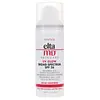What's inside
What's inside
 Key Ingredients
Key Ingredients

 Benefits
Benefits

 Concerns
Concerns

 Ingredients Side-by-side
Ingredients Side-by-side

Zinc Oxide 20.15%
Cosmetic ColorantWater
Skin ConditioningCoco-Caprylate/Caprate
EmollientNiacinamide
SmoothingIsopropyl Myristate
EmollientPolyglyceryl-3 Diisostearate
EmulsifyingEthyl Macadamiate
Skin ConditioningMica
Cosmetic ColorantGlycerin
HumectantPropanediol
SolventCetearyl Nonanoate
EmollientCapryloyl Glycerin/Sebacic Acid Copolymer
Skin ConditioningUndecane
EmollientCaprylic/Capric Triglyceride
MaskingTridecane
PerfumingPolyglyceryl-3 Polyricinoleate
EmulsifyingDisteardimonium Hectorite
StabilisingPhenoxyethanol
PreservativeOctyldodecyl Oleate
EmollientSodium Chloride
MaskingMagnesium Sulfate
Tocopheryl Acetate
AntioxidantIsostearic Acid
CleansingCocos Nucifera Fruit Extract
EmollientXanthan Gum
EmulsifyingBisabolol
MaskingSilica
AbrasiveSodium Hyaluronate
HumectantAloe Barbadensis Leaf Juice
Skin ConditioningLactic Acid
BufferingZingiber Officinale Root Extract
MaskingErgothioneine
AntioxidantIron Oxides
Zinc Oxide 20.15%, Water, Coco-Caprylate/Caprate, Niacinamide, Isopropyl Myristate, Polyglyceryl-3 Diisostearate, Ethyl Macadamiate, Mica, Glycerin, Propanediol, Cetearyl Nonanoate, Capryloyl Glycerin/Sebacic Acid Copolymer, Undecane, Caprylic/Capric Triglyceride, Tridecane, Polyglyceryl-3 Polyricinoleate, Disteardimonium Hectorite, Phenoxyethanol, Octyldodecyl Oleate, Sodium Chloride, Magnesium Sulfate, Tocopheryl Acetate, Isostearic Acid, Cocos Nucifera Fruit Extract, Xanthan Gum, Bisabolol, Silica, Sodium Hyaluronate, Aloe Barbadensis Leaf Juice, Lactic Acid, Zingiber Officinale Root Extract, Ergothioneine, Iron Oxides
Zinc Oxide 24%
Cosmetic ColorantWater
Skin ConditioningC12-15 Alkyl Benzoate
AntimicrobialIsopropyl Palmitate
EmollientButyloctyl Salicylate
Skin ConditioningEthylhexyl Pelargonate
EmollientCetyl PEG/PPG-10/1 Dimethicone
EmulsifyingPropylene Glycol
HumectantCyclopentasiloxane
EmollientBis-Octyldodecyl Dimer Dilinoleate/Propanediol Copolymer
EmollientDimethicone
EmollientEthylhexyl Methoxycrylene
Skin ConditioningPolyester-27
Triethoxycaprylylsilane
Beeswax
Emulsion StabilisingHydroxyacetophenone
AntioxidantSodium Chloride
MaskingPEG-12 Dimethicone
Skin Conditioning1,2-Hexanediol
Skin ConditioningCaprylyl Glycol
EmollientTocopherol
AntioxidantZinc Oxide 24%, Water, C12-15 Alkyl Benzoate, Isopropyl Palmitate, Butyloctyl Salicylate, Ethylhexyl Pelargonate, Cetyl PEG/PPG-10/1 Dimethicone, Propylene Glycol, Cyclopentasiloxane, Bis-Octyldodecyl Dimer Dilinoleate/Propanediol Copolymer, Dimethicone, Ethylhexyl Methoxycrylene, Polyester-27, Triethoxycaprylylsilane, Beeswax, Hydroxyacetophenone, Sodium Chloride, PEG-12 Dimethicone, 1,2-Hexanediol, Caprylyl Glycol, Tocopherol
 Reviews
Reviews

Ingredients Explained
These ingredients are found in both products.
Ingredients higher up in an ingredient list are typically present in a larger amount.
Chances are, you eat sodium chloride every day. Sodium Chloride is also known as table salt.
This ingredient has many purposes in skincare: thickener, emulsifier, and exfoliator.
You'll most likely find this ingredient in cleansers where it is used to create a gel-like texture. As an emulsifier, it also prevents ingredients from separating.
There is much debate on whether this ingredient is comedogenic. The short answer - comedogenic ratings don't tell the whole story. Learn more about comegodenic ratings here.
The concensus about this ingredient causing acne seems to be divided. Research is needed to understand if this ingredient does cause acne.
Scrubs may use salt as the primary exfoliating ingredient.
Learn more about Sodium ChlorideWater. It's the most common cosmetic ingredient of all. You'll usually see it at the top of ingredient lists, meaning that it makes up the largest part of the product.
So why is it so popular? Water most often acts as a solvent - this means that it helps dissolve other ingredients into the formulation.
You'll also recognize water as that liquid we all need to stay alive. If you see this, drink a glass of water. Stay hydrated!
Learn more about WaterZinc Oxide is a mineral broad-spectrum UV filter; it is the broadest UVA and UVB reflector approved by the FDA. It also has skin protectant and skin soothing properties.
Zinc oxide is one of the most effective broad-spectrum UV filters. It protects against UVB, UVAII, and UVAI. In comparison to its counterpart titanium dioxide, zinc oxide provides uniform and extended UVA protection.
Another great benefit? This ingredient is highly photostable so it won't degrade easily under sunlight.
A common myth is that mineral UV filters are widely believed to primarily reflect UV light.
However, modern research shows titanium dioxide absorbs UV radiation like chemical filters (~95% absorption & 5% reflection).
Zinc oxide has great skin soothing properties so you'll likely find this in sunscreens formulated for sensitive skin or babies/children. It is unlikely to cause "eye sting" like other sunscreen ingredients.
Regulatory agencies consider zinc oxide to be non-toxic and safe. It has also been shown to not penetrate the skin.
Unfortunately, this ingredient does leave a visible white cast. This is why mineral sunscreens are often less cosmetically elegant than chemical or hybrid ones.
In cosmetics, zinc oxide can be found in both non-nano and nano-sized forms. The nano version is used to reduce white cast and improve the texture of sunscreen formulas.
There are ongoing concerns surrounding nano-zinc oxide's impact on marine ecosystems and whether it can be absorbed into skin.
Regarding marine ecosystems and coral reefs, there is no conclusive evidence that any form of zinc oxide (or any other sunscreen ingredients) will cause harm. The science is still developing but many consumers are keeping a close eye on this issue.
Please note, many destinations have reef-safety sunscreen rules. For instance, the U.S. Virgin Islands advises all visitors to use non-nano mineral sunscreens.
There has also been some stir about whether micronized or nano zinc oxide has potential photoxicity and absorption through the skin/lungs.
An in-vitro (done in a test tube or petri dish) study demonstrated micronized zinc oxide to have potential phototoxicity. There's no need to fret; the EU Commission's Scientific Committee on Consumer Safety has stated, "The relevance of these findings needs to be clarified by appropriate investigations in vivo." Or in other words, further studies done on living organisms are needed to prove this.
Current research shows zinc oxide nanoparticles do not penetrate intact or sunburned skin. They either remain on the surface or in the outermost layer of dead skin (stratum corneum).
Zinc oxide is one of only two classified mineral UV filters with titanium dioxide being the other one.
Fun fact: Zinc has been used throughout history as an ingredient in paint and medicine. An Indian text from 500BC is believed to list zinc oxide as a salve for open wound. The Ancient Greek physician Dioscorides has also mentioned the use of zinc as an ointment in 1AD.
Learn more about Zinc Oxide